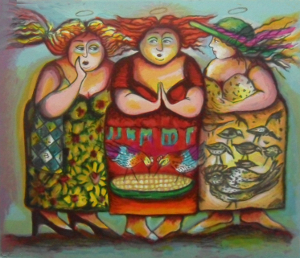 Heavenly Gossips
Heavenly Gossips
Martha Jiménez
Serigraphy in 62 colours
40 cm x 30 cm
Ed. 3
“Heavenly Gossips” by Martha Jiménez is a coloured serigraphy. Three voluptuous women with waving hair are standing close together and take up the most of the pictorial space. They are wearing nice dresses. All three have a small ellipse floating above their head, like a halo. The background is bright turquoise, with some shadows, but the source of light is ambiguous.
The woman on the left side wears a green dress with big yellow sunflowers. Her blond hair is tied in two sideward braids. On her angled right arm she holds a bag with blue, white and yellow lozenges. Her right hand is led beside her mouth as if she is whispering something to her neighbour. This gesture is underlined by her sight in the same direction.
In the middle stands a red haired female, wearing a red dress with two colourful birds picking grains on it. Her hands are joined like in prayer and the mouth is roundly opened, so that it looks as if she is singing. Nevertheless, her eyes have wandered to her right side: her attention is directed to her neighbour, even though her posture seems to express inner contemplation.
The woman on the right side, in a yellow dress with grey and yellow birds, has turned her torso and face to the other two. Unlike these, she is wearing a green hat with colourful ribbons. Her left arm is bent in a right angle. This gesture might underline that she is following the conversation and that she will intervene in any moment.
Due to the composition and gestures, the group is closed in itself. None of the women is looking to the viewer, they are only interested in each other or the subject of the chat and do not need anybody else to exist in this very moment. The halos above their heads underline this heavenly condition.
In addition, there are other elements, which refer to the state of liberty of these women, like the birds and the flying hair. The hair is not directed by an external force like the wind, it is the women’s freedom to let it wave to wherever they want. Their bodies are deliberated from the western beauty ideal of unnatural slim shape; neither they need to hide it. The bright colours of their dresses and the whole painting might stand for vitality and the joy of life.
Furthermore, Martha Jiménez voluptuous women of her gossip series symbolise more universal values: fertility, sensuality, acceptance and eroticism. They are self-determined protagonists in their own life.
Martha Jiménez
Born in 1948, Martha graduated in plastic arts and was one of the first alumni of the Cuban Art Instructors’ School. Her artistic disciplines – which she practices and teaches – are painting, sculpture, ceramics and printmaking. Besides her creations in all these fields, she is specified in terracotta sculptures and won in 1997 the International UNESCO prize for those ceramic creations.
Moreover, Martha is granted by countless national and international awards. In particular, she was recognised at the fifth International Sculpture Symposium in Turkey in 2011, the fourth International Ceramic Tile Triennial and the Shanghai Biennale both in 2010. Among other pieces in public space, she created a series of bronze sculptures for the Plaza del Carmen in Camagüey. Including chairs and benches, she portrayed the people of her neighbourhood in life-size.
Martha’s extensive oeuvre was shown since 1967 in more than 250 exhibitions in Cuba and abroad, like the United States, Canada and many Latin American countries. In the last years, her works were also on view in Europe and are represented in several public and private collections. In addition to her own inventions, she supports children and nascent artists with workshops and participative projects, besides her teacher activity at the Fidelio Ponce Academy of Plastic Arts and Design.
One of the artist’s main subject are women. Without any influence of the Colombian artist Fernando Botero, Martha creates them voluptuous, with enormous hips, fleshy lips and often waving hair. Another recurring element is the fish, whose movement is similar to the women’s: fast and free, like it is stated at her website. Furthermore, there is the sewing machine as symbol of female work and a personal hint to her mother.
Martha lives and works in Camagüey, Cuba.
